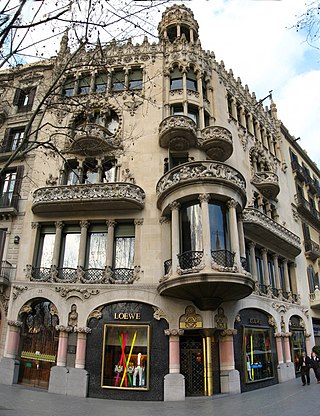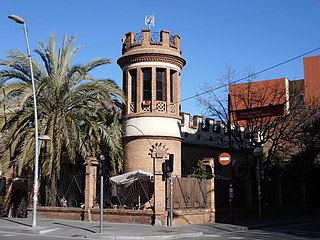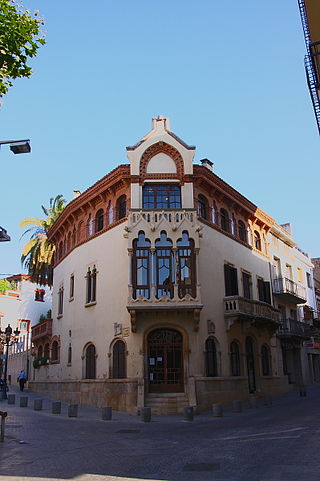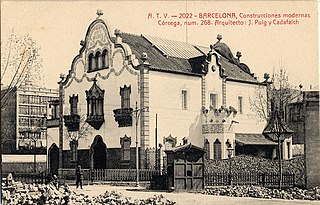
The Eixample is a district of Barcelona between the old city and what were once surrounding small towns, constructed in the 19th and early 20th centuries. Its population was 262,000 at the last census (2005).

Reus is the capital of Baix Camp, in Camp de Tarragona, Catalonia, Spain. The area has always been an important producer of wines and spirits, and gained continental importance at the time of the Phylloxera plague. Currently it is known for its commercial activity, for being a centre for rock-climbing and as the birthplace of architect Antoni Gaudí.

The former Hospital de la Santa Creu i Sant Pau in the neighborhood of El Guinardó, Barcelona, Catalonia, Spain, is a complex built between 1901 and 1930. It is one of the most prominent works of the Catalan modernisme architect Lluís Domènech i Montaner. The complex was listed as a Conjunto Histórico in 1978. Together with Palau de la Música Catalana, it was declared a UNESCO World Heritage Site in 1997.

Palau de la Música Catalana is a concert hall in Barcelona, Catalonia, Spain. Designed in the Catalan modernista style by the architect Lluís Domènech i Montaner, it was built between 1905 and 1908 for Orfeó Català, a choral society founded in 1891 that was a leading force in the Catalan cultural movement that came to be known as the Renaixença. It was inaugurated on 9 February 1908.

Modernisme, also known as Catalan modernism and Catalan art nouveau, is the historiographic denomination given to an art and literature movement associated with the search of a new entitlement of Catalan culture, one of the most predominant cultures within Spain. Nowadays, it is considered a movement based on the cultural revindication of a Catalan identity. Its main form of expression was Modernista architecture, but it also encompassed many other arts, such as painting and sculpture, and especially the design and the decorative arts, which were particularly important, especially in their role as support to architecture. Modernisme was also a literary movement.

Lluís Domènech i Montaner was a Catalan architect who was very much involved in and influential for the Catalan Modernisme català, the Art Nouveau/Jugendstil movement. He was also a Catalan politician.

The Fundació Antoni Tàpies is a cultural center and museum, located in Carrer d'Aragó, in Barcelona, Catalonia. It is dedicated mainly to the life and works of the painter Antoni Tàpies.

Passeig de Gràcia is one of the major avenues in Barcelona (Catalonia) and one of its most important shopping and business areas, containing several of the city's most celebrated pieces of architecture. It is located in the central part of Eixample, stretching from Plaça Catalunya to Carrer Gran de Gràcia.

The Illa de la Discòrdia or Mansana de la Discòrdia — "Block of Discord"; Spanish: Manzana de la Discordia — is a city block on Passeig de Gràcia in the Eixample district of Barcelona, Catalonia, Spain. The block is noted for having buildings by four of Barcelona's most important Modernista architects, Lluís Domènech i Montaner, Antoni Gaudí, Josep Puig i Cadafalch and Enric Sagnier, in close proximity. As the four architects' styles were very different, the buildings clash with each other and the neighboring buildings. They were all built in the early years of the 20th century.

The Casa Lleó Morera is a building designed by noted modernisme architect Lluís Domènech i Montaner, located at Passeig de Gràcia 35 in the Eixample district of Barcelona. In 1902 Francesca Morera assigned Lluís Domènech i Montaner to remodel ancient "casa Rocamora", built in 1864. She died in 1904, and the building was named after her son, Albert Lleó i Morera. The building is located on the corner of Carrer del Consell de Cent, and is one of the three important buildings of Barcelona's Illa de la Discòrdia, and it is the only building of the block awarded Barcelona's town council's Arts Building Annual Award, obtained in 1906. The building lost some of its most representative elements, such as the tempietto on its top and the ground floor and mezzanine's architectural sculpture. The building is also known as the residence of Cuban-Catalan photographer Pau Audouard.

Josep Vilaseca i Casanovas was a Spanish architect and artist who formed part of the Modernista movement.

Casa Agustí is a modernista building in the Progrés quarter of Badalona built in 1893. It was designed by the renowned architect Lluís Domènech i Montaner as the residence of the engineer Eduard Agustí Saladrigas. The building became a restaurant in 1936 and currently serves food and refreshments. Among its remarkable features are the round red brick tower and the surrounding gardens. The nearest existing Barcelona Metro station is Pep Ventura, and notoriously the undergoing extension of the metro network has allegedly damaged its façade.

Casa Navàs is a modernist building in the city of Reus, Catalonia, Spain. Casa Navàs is a building designed by Catalan architect Lluís Domènech i Montaner, located in the city's Plaça del Mercadal.

L'Institut Pere Mata is a psychiatric hospital in Reus, Catalonia, Spain. The building was designed by the Catalan Modernist architect Lluís Domènech i Montaner. The hospital predates Hospital Sant Pau of Barcelona and it has a similar structure. Lluís Domènech i Montaner followed the structure of different buildings for different specialities.

The Casa Gasull is a building in Reus, Catalonia, Spain, designed by Modernista architect Lluís Domènech i Montaner.

The Lluís Domènech i Montaner House-Museum, in Canet de Mar, in the region of El Maresme, is a space dedicated to the study of the life and works of architect Lluís Domènech i Montaner. The House-Museum includes the Domènech house, a work of the architect in collaboration with his son, Pere Domènech and his son-in-law, Francesc Guàrdia, and the 16th-century Can Rocosa farmhouse, which Domènech i Montaner converted into his workshop-study. The House-Museum is part of the Barcelona Provincial Council Local Museum Network.

Casa Trinxet was a building designed by the Catalan Modernisme architect Josep Puig i Cadafalch and built during the years 1902–1904, officially considered completed in 1904. It was located at the crossroads of Carrer Balmes and Carrer del Consell de Cent, in the Eixample district of Barcelona, Catalonia, Spain. Casa Trinxet was "one of the jewels of Barcelona Modernisme" and one of the buildings of Barcelona's Illa de la Discòrdia, because of competing attitudes among Domènech i Montaner, Puig i Cadafalch and Antoni Gaudí.

The Castle of the Three Dragons, is the popular name given to the modernisme building built between 1887 and 1888 as a Café-Restaurant for the 1888 Universal Exposition of Barcelona by Lluís Domènech i Montaner. This name was probably adopted from the 1865 play by Serafí Pitarra.

Enric Catà i Catà (1878–1937) was a modernista architect from Barcelona (Catalonia).

The Palau Baró de Quadras is a small modernista palace located in Barcelona on Avinguda Diagonal, equidistant from La Pedrera and Casa de les Punxes. It was built by the Catalan architect Josep Puig i Cadafalch between 1904 and 1906. In 1976 it was designated as Nacional National Historical Monument of Artistic Interest. Currently houses the main offices of the Institut Ramon Llull.




















